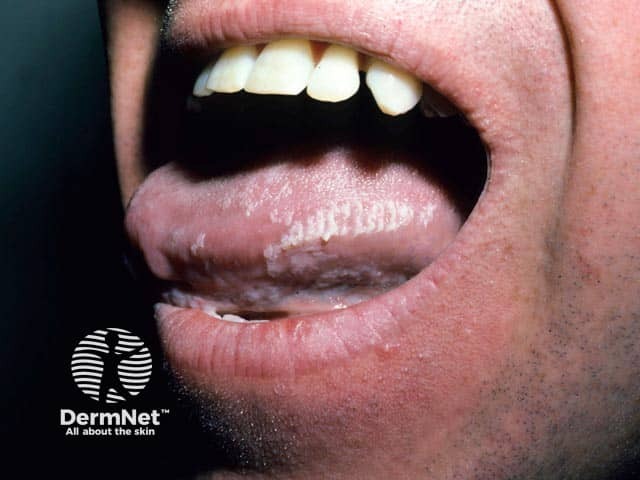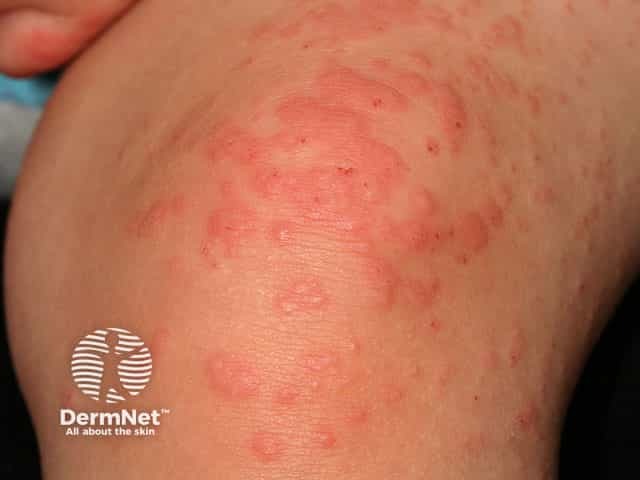Main menu
Common skin conditions

NEWS
Join DermNet PRO
Read more
Quick links
Epstein-Barr virus — extra information
Epstein-Barr virus
Author: Hana Numan, Medical Writer, New Zealand. Copy edited by Gus Mitchell. October 2021
Introduction
Demographics
More information
Clinical features
Complications
Diagnosis
Differential diagnoses
Treatment
Outcome
What is Epstein-Barr virus?
Epstein-Barr virus is one of the most ubiquitous human viruses, with up to 95% of adults worldwide having been infected.
Epstein-Barr virus (EBV) is also called Human herpesvirus 4 (HHV-4).
Who gets Epstein-Barr virus infections?
- People of any age can acquire EBV, although primary infection usually occurs in childhood and adolescence.
- EBV affects both sexes equally and all races. However, the age of first acquisition varies widely between ethnic groups.
- Infection occurs globally and has no seasonal preference.
Tell me more about Epstein-Barr virus
Epstein-Barr virus is a member of the order Herpesvirales, family Herpesviridae, subfamily Gammaherpesvirinae, genus Lymphocriptovirus.
Herpes viruses are characterised by:
- Double-stranded DNA genome
- Icosahedral capsid surrounded by a poorly defined protein tegument
- Lipid envelope derived from the membrane of an infected cell modified by inclusion of viral-encoded glycoproteins
- Diameter of 160-200 nm
- Infectious, latent, and reactive phases of infection.
How is Epstein-Barr virus spread?
Epstein-Barr virus may be passed from person to person via:
- Saliva: deep kissing, premastication of food by carers of infants, sharing food and eating utensils or a toothbrush (the virus survives on objects while it remains moist)
- Other body fluids: blood and semen during sexual contact, blood transfusion, organ transplantation, and other procedures.
The incubation period is about six weeks. Following primary infection, EBV enters a latent phase in B lymphocytes from which it can be reactivated, especially if immunocompromised. Virus shedding and transmission can occur during primary infection or intermittently during reactivation.
What are the clinical features of Epstein-Barr virus infection?
Epstein-Barr virus is best known for causing infectious mononucleosis (glandular fever) in adolescents and young adults, although primary EBV infection can be asymptomatic (10%) particularly in children.
EBV can also cause other disorders with mucocutaneous features, and has been implicated in the pathogenesis of many more.
Table 1. EBV infections with mucocutaneous clinical features
Disorder |
Mucocutaneous features |
Infectious mononucleosis |
Palatal petechiae, rash, eyelid/periorbital swelling |
Papular rash over buttocks, thighs, arms, face |
|
Painful deep punched out ulcer(s) on the genitalia |
|
Asymptomatic white plaques on the lateral tongue |
|
Symmetrical painful erythema and oedema of hands and feet |
|
Pink papules beginning in the armpit or groin, spreading along one side of the trunk |
|
Photosensitivity |
|
One form is classified as chronic active EBV infection in childhood |
|
Chronic active EBV |
Persistent or recurrent IM-like symptoms including of the skin unable to be explained by other known processes |
Jaundice, itch |
EBV, Epstein-Barr virus; IM, infectious mononucleosis

Infectious mononucleosis: ampicillin rash. Wikimedia Commons

Oral hairy leukoplakia

Papular acrodermatitis of childhood
EBV has been postulated to trigger a number of autoimmune conditions in genetically predisposed individuals: examples include systemic lupus erythematosus, Sjögren syndrome, and dermatomyositis.
Table 2. Other mucocutaneous disorders in which EBV may be implicated
Disorder |
Role of EBV |
Both the acute and chronic forms have been postulated to be triggered by infectious agents |
|
EBV DNA has been detected by PCR in some (but not all) tissue samples of LCH |
|
Congenital infection by EBV can present with this phenotype |
EBV, Epstein-Barr virus; LCH, Langerhans cell histiocytosis; PCR, polymerase chain reaction
What are the complications of Epstein-Barr virus infection?
Epstein-Barr virus is implicated in many lymphoproliferative disorders and tumours. Examples include:
- Nasopharyngeal carcinoma
- Endemic Burkitt lymphoma, Hodgkin lymphoma
- EBV-associated haemophagocytic lymphohistiocytosis.
How is Epstein-Barr virus infection diagnosed?
Epstein-Barr virus infection will be considered on the clinical presentation and confirmed on investigations which may include:
- Monospot test for heterophile antibodies [see Infectious mononucleosis]
- Full blood examination — elevated lymphocyte count, atypical lymphocytes
- Liver function tests and other organ specific investigations depending on clinical presentation
- Serology for EBV-specific IgM and IgG
- PCR for EBV can be performed on mucosal swabs, plasma, in lymphocyte subsets, and tissue samples.
[see Laboratory tests for viral infections]
What is the differential diagnosis for Epstein-Barr virus-related conditions?
- Other viral infections eg, cytomegalovirus, adenovirus, influenza, acute human immunodeficiency virus infection syndrome, COVID-19
- Other infections including toxoplasmosis and streptococcal pharyngitis
What is the treatment for Epstein-Barr virus infection?
Prevention
- Currently no vaccine available
General measures
- Symptomatic relief
- Avoid antibiotic use
Specific measures
- No specific antiviral treatment for EBV
- Treatment of the specific manifestation
What is the outcome for Epstein-Barr virus infection?
Epstein-Barr virus infection becomes latent with the risk of reactivation in later life.
The age at which EBV is acquired influences the clinical picture and complications. Primary infection in adolescents and adults is more likely to result in infectious mononucleosis than if infection occurs in childhood, and IM carries an increased risk of subsequent development of Hodgkin lymphoma. Primary infection in early childhood is associated with subsequent nasopharyngeal carcinoma or Burkitt lymphoma.
Bibliography
- Chuh A, Zawar V, Sciallis GF, Kempf W, Lee A. Pityriasis rosea, Gianotti-Crosti syndrome, asymmetric periflexural exanthem, papular-purpuric gloves and socks syndrome, eruptive pseudoangiomatosis, and eruptive hypomelanosis: do their epidemiological data substantiate infectious etiologies? Infect Dis Rep. 2016;8(1):6418. doi:10.4081/idr.2016.6418. PubMed Central
- Dunmire SK, Hogquist KA, Balfour HH. Infectious mononucleosis. Curr Top Microbiol Immunol. 2015;390(Pt 1):211–40. doi:10.1007/978-3-319-22822-8_9. PubMed Central
- Dunmire SK, Verghese PS, Balfour HH Jr. Primary Epstein-Barr virus infection. J Clin Virol. 2018;102:84–92. doi:10.1016/j.jcv.2018.03.001. PubMed
- Eminger LA, Hall LD, Hesterman KS, Heymann WR. Epstein-Barr virus: dermatologic associations and implications: part II. Associated lymphoproliferative disorders and solid tumors. J Am Acad Dermatol. 2015;72(1):21–36. doi:10.1016/j.jaad.2014.07.035. Journal
- Hall LD, Eminger LA, Hesterman KS, Heymann WR. Epstein-Barr virus: dermatologic associations and implications: part I. Mucocutaneous manifestations of Epstein-Barr virus and nonmalignant disorders. J Am Acad Dermatol. 2015;72(1):1–20. doi:10.1016/j.jaad.2014.07.034. Journal
- Kimura H, Cohen JI. Chronic active Epstein-Barr virus disease. Front Immunol. 2017;8:1867. doi:10.3389/fimmu.2017.01867. Journal
- Rosales Santillan M, Dietert JB, Jahan-Tigh R. Adult-onset papular purpuric gloves and socks syndrome. Dermatol Online J. 2018;24(4):13030/qt02x2h6sd. Journal
On DermNet
- Epstein-Barr virus-associated lymphoproliferative disorders
- Herpes viruses
- Infectious mononucleosis
- Viral infections and the skin
Other websites
- Epstein-Barr virus — CDC
